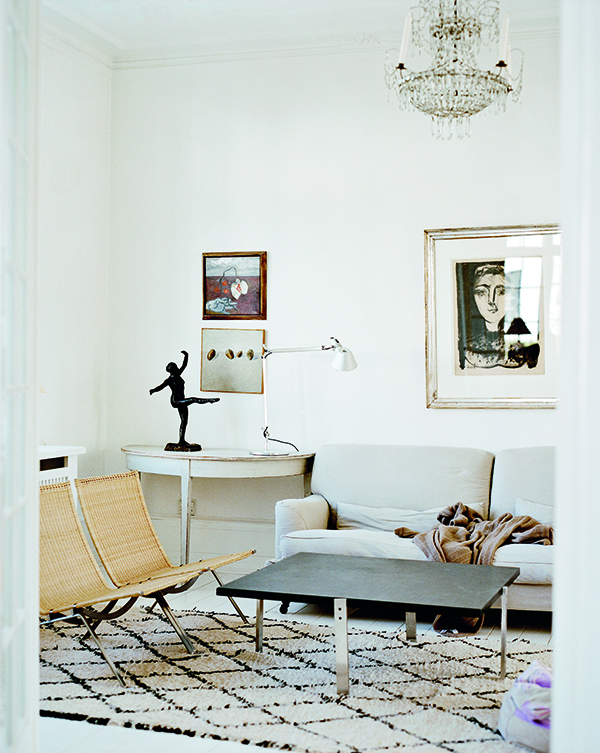 Photography by GAELLE LE BOULICAUT
Photography by GAELLE LE BOULICAUT
Design
Holm at Home
JACOB HOLM CAME TO DESIGN IN A WAY THAT now seems as if it was almost inevitable. He was in his first year at the University of Copenhagen, and took out a student loan to buy furniture for his apartment. Most nineteen-year-olds would go the futon route, but Holm spent the entire loan on two PK22 chairs and a PK61 coffee table table by Poul Kjærholm. “I had to sleep on a mattress and just make do without any other furniture,” he recalls.
Today he is president and CEO of the venerable Danish furniture company Fritz Hansen and charged with protecting a design legacy that dates back to 1872. “This is a company built on the tradition of what Danish design is, where it came from. It’s a company that was inspired by the Bauhaus and took the Bauhaus to Denmark,” he says. This is a mandate he takes seriously—continuing the “history of craftsmanship of the carpenters and the craftsmen, the way they used wood and leather.” Holm came to Fritz Hansen in 1998 after working in New York and Paris as well as Copenhagen, where he headed the Scandinavian arm of the giant advertising firm Saatchi and Saatchi. “The dynamics of architecture and thereby design have always interested me. I’m fascinated by the intelligence and the ambition of design— and of course functionalism, minimalism, surface, and much more.” Fritz Hansen’s showrooms speak to those ethics of craftsmanship and modernism. “You ask yourself, ‘what is the purpose of this?’” Holm says. “You ask, ‘how do you sit in it? Does it fit the body?’ That is actually the principle of form follows function.”
His home does indeed showcase Fritz Hansen furniture, but for very different (and noncommercial) reasons. “To my mind there is an optimal way of living, and my wife has been the one who has taught me that a home should be livable,” he says. “It’s not a place for display and not a place for bragging. Our house is not a showroom.” Holm’s wife, Barbara Bendix Becker, is an industrial designer, “which means,” he says, “that we often discuss aesthetics and design at the table. It’s a part of our life.” They are parents to two teenaged daughters, Selma and Lilli.
The Holm family lives in the coastal suburb of Klampenborg, just north of Copenhagen. The house itself dates to 1903 and is part of two thirtyunit complexes designed by the Danish architect Rasmus Jensen in the Regency style, each built around a courtyard, and together known as the British Townhouses. Architecture and location are “very traditional and somewhat secluded,” Holm says. The kitchen and dining area are on the bottom floor, the living spaces—living rooms and a library—on the next, and bedrooms on the two floors above. It is a tall house with high ceilings and lofty windows, and lots of steps between each floor. “We live on staircases,” Holm says, “running up and down the stairs all day.”
The house is filled with family treasures, handed down from generation to generation, along with enough Poul Kjærholm to prove that Holm didn’t misspend in his youth. To be sure, there are Fritz Hansen pieces in the mix, among them two of the company’s most-famous-ever designs, an Arne Jacobsen Egg chair along with a number of Jacobsen’s Series 7 chairs in both adult and child sizes. Yet the furniture is there for the sitting, not for the seeing. “We have old design, vintage pieces from my family, and vintage pieces from my wife’s family,” Holm says. “There are stains. There are small spots. Over the years these are the diary of my family.”
The Vico Magistretti sofa in the living room represents a particular moment in Holm’s career. Magistretti was designing furniture for Fritz Hansen (the VicoDuo chair and the Vicolounge chair are among his pieces for the company) when Holm took over as chief executive officer in 1998. The two became fast friends, and the Italian designer lived at Holm’s house during his stints in Copenhagen. “We had big discussions, ranging from what is the meaning of design to what is the meaning of life,” Holm says.
Also in the living room are a Moroccan rug, Serge Mouille lighting, the two Poul Kjærholm PK22 chairs from his student days, a slatetopped PK65 coffee table, and a nineteenthcentury Danish chest of drawers. The adjacent library is floor-to-ceiling books, and, Holm says, “it is books that are read, by the way. I can’t stand bookshelves filled with books not meant to be read.”
The paintings, sculpture, and other artworks follow suit. A prized piece is a Degas sculpture, a ballet dancer, yet there is also a cast-iron duck that has been in Barbara’s family for generations. “In our family we are not professional collectors, but we love to surround ourselves with beautiful objects,” Holm says. Their collection also includes pieces by Pablo Picasso (a lithograph), the contemporary German artist Daniel Lergon, and a number of twentieth century Danish artists including Hans Bendix (who was Barbara’s grandfather), Mogens Andersen, and Vilhelm Lundstrøm.
Whether it is art or design, each piece has a tale to tell. “There are stories behind each individual piece, and one can relate to it,” Holm says. “If you surround yourself with things that have stories, and you are part of the story, well that’s what creates the ambiance of living. It’s the fundamental part of living.”










